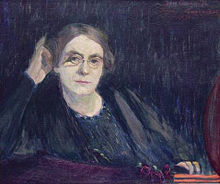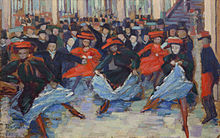Ida Gerhardi
Ida Gerhardi (born August 2, 1862 in Hagen ; † June 29, 1927 in Lüdenscheid ) was a painter of classical modernism . From 1891 to 1913 she stayed mainly in Paris. Many of her works were created during this time. In addition to painting, she also made a contribution to the German-French cultural exchange.
Life
Ida Gerhardi was born in Hagen as the daughter of the doctor August Gerhardi (1831–1869) and Mathilde (1840–1917), a née Dieckmann. After the early death of the father in 1869, the family moved to live with relatives in Detmold , where the artist attended the secondary school for girls. At the age of 28 she was able to assert her wish to study painting. First she studied in 1890 at the women's academy of the Munich Artists' Association , primarily with the landscape painter Tina Blau .
In 1891 she went to Paris and in the following years studied at the Académie Colarossi , a private school that was particularly popular with young women and foreign students, as the state academy was difficult to access for them. She was close friends with the painter Jelka Rosen and her future husband, the composer Frederick Delius , for whose musical performances she campaigned in Germany (e.g. German premiere in Elberfeld in 1897). Since 1900 she was in contact with the sculptor Auguste Rodin and a little later she joined the circle of artists at the Café du Dôme on Montparnasse . She is counted among the so-called painters of Paris. In Paris and Germany she cultivated artist friendships with Käthe Kollwitz , Ottilie Roederstein , Maria Slavona , Friedrich Ahlers-Hestermann , Franz Nölken as well as with the art collectors and art historians Wilhelm Uhde , Otto Ackermann and Walter Kaesbach .
Gerhardi was involved in the mediation of works of art, their sale and the organization of exhibitions. She introduced the Hagen museum founder Karl Ernst Osthaus to Rodin and Aristide Maillol and brokered purchases for his museum in Hagen, today's Osthaus Museum Hagen . In 1907 she organized an exhibition of French art in Berlin (Kunstsalon Schulte) and in 1910 an exhibition of German art in Paris (gallery of the Les Tendances Nouvelles exhibition association on the Champs-Elysées). She traveled to Leipzig , Berlin , Weimar and Hagen for art education and portraits .
Ida Gerhardi was a member of the German Association of Artists . Her works were represented at exhibitions in Paris at the Salon de l'Union internationale des Beaux-arts (1910), the Salon des Indépendants and in Germany at the Berlin Secession and the Munich Secession . For health reasons she had to give up her Paris studio in 1913 and from then on lived in the family home in Lüdenscheid. After her death in 1927, she was buried in the family grave in Detmold . The city council of Detmold declared her grave in the old cemetery in 2013 as a grave of honor. She left letters that were first published by Annegret Rittmann in 1993.
Works

Initially, Ida Gerhardi concentrated on landscape painting, which was close to the atmospheric rendering of nature in the Barbizon school , but was already impressionistic in capturing light and atmosphere. Then she specialized increasingly as a portraitist. At first she traditionally painted in dark, subdued colors, but as early as 1896 the color palette lightened, the coloring became clearer and brighter.
The portraits of artist friends such as the musicians Arthur Nikisch (1899), Frederick Delius (1912) and Ferruccio Busoni (1902, lost) or the painter Christian Rohlfs (1906) as well as the museum's founder Karl-Ernst Osthaus ( 1903).
With self-portraits from the entire creative period, she documented her own condition and social position as a woman in art . Significant are her pictures from Parisian entertainment venues such as the Bal Bullier , which she visited between 1903 and 1905, partly together with Käthe Kollwitz. Numerous sketches were created there as the basis of her works. There are mostly dance scenes in brightly lit halls, but also reproductions of the gloomy, so-called Apache pubs. Women have only recently been allowed to walk unaccompanied through a big city; She was hardly allowed to visit places like the bars she painted. Gerhardi is thus a pioneer in art history - no woman before her painted this subject.
In Biarritz, Ida Gerhardi painted various pictures of the sea in 1905. In addition to the portraits, cityscapes, genre pictures and still lifes were also created, especially in the late period . From around 1900 she had approached the French late Impressionists and Fauvists in terms of color and painting . Under the influence of Rhenish Expressionism , around 1911 the colors became more pastel and the shape more contoured. Despite tendencies towards abstraction, she always remained committed to the object and the characterization of people remained a constant concern.
Her work includes paintings and drawings e.g. B .:
- Tanzbild VIII , around 1904: City Museum Lüdenscheid
- Madame Riau (Chanteuse) , 1903; Bal Bullier , 1903; Tanzbild XII , 1905; approx. 30 drawings; all: Westfälisches Landesmuseum , Münster
- Siamese Prince , 1908: Museum Kunstpalast Düsseldorf
- The violinist (Elly Bößneck) , 1911; Christian Rohlfs , 1906; both: Museum Folkwang , Essen
- Berta Stoop , 1911; Self-portrait 1920, both: Karl Ernst Osthaus-Museum Hagen
Exhibitions and catalogs
- 2004: Femme flaneur , exhibition catalog, Bonn, August Macke-Haus
- 2008: Places of Longing , exhibition catalog, Münster, State Museum for Art and Cultural History
- 2012: Ball rush and blaze of color. Ida Gerhardi in Paris , State Museum for Art and Cultural History Oldenburg, Prinzenpalais (with catalog)
- 2012 Ida Gerhardi - German women artists in Paris around 1900 , Städtische Galerie Lüdenscheid, Städtische Galerie Lüdenscheid . Susanne Conzen (Ed.): Exhibition catalog. Hirmer, 2012, ISBN 978-3-7774-4791-9
- 2013: Exhibition of a selection of the “dance pictures” in the city gallery Schwalenberg
- 2016: The painters of Paris , Jesuit Church Aschaffenburg
- 2016: Group exhibition Empathy and Abstraction. The modern age of women in Germany , Kunsthalle Bielefeld .
theatre
In 2013 the musical Ida about the life of Ida Gerhardi was presented with the support of the Ministry for Family, Children, Youth, Culture and Sport of the State of North Rhine-Westphalia under the direction of Melanie Blank and through artistic participation a. a. Performed by Maria Kübeck and Jörn Kitzhöfer in various cities in North Rhine-Westphalia (including the Bielefeld theater laboratory ).
Honors
The Ida Gerhardi Sponsorship Prize , which Sparkasse Lüdenscheid has been donating every two years since 1989, is named after Ida Gerhardi . An exhibition in the Städtische Galerie Lüdenscheid is connected with the award of the prize. Young artists who have completed their studies are supported. The prize is endowed with 5,000 euros, and a further 3,000 euros are available as production costs for an edition that is produced in collaboration with the Städtische Galerie Lüdenscheid.
Previous winners were:
- 2019: David Semper
- 2016: Ail Hwang
- 2013: Gesine Grundmann
- 2011: Marcel Hiller
- 2009: Tina Tonagel
- 2007: Adriane Wachholz
- 2005: Kati Faber
- 2003: Neringa Naujokaite
- 2001: Erich Reusch
- 1999: Tobias Gereon Gerstner
- 1997: Amalia Theodorakopoulos
- 1995: Victor Bonato
- 1993: Johannes Sandberger
- 1991: Jochem Ahmann
- 1989: Claudia Terstappen
literature
- Gerhardi, Ida . In: Ulrich Thieme (Hrsg.): General Lexicon of Fine Artists from Antiquity to the Present . Founded by Ulrich Thieme and Felix Becker . tape 13 : Gaab-Gibus . EA Seemann, Leipzig 1920, p. 457 ( Textarchiv - Internet Archive ).
- Gerhardi, Ida . In: Hans Vollmer (Hrsg.): General Lexicon of Fine Artists of the XX. Century. tape 2 : E-J . EA Seemann, Leipzig 1955, p. 229 .
- Annegret Rittmann: Gerhardi, Ida . In: General Artist Lexicon . The visual artists of all times and peoples (AKL). Volume 52, Saur, Munich a. a. 2006, ISBN 3-598-22792-2 , p. 115.
- Vera Scheef: The artist Ida Gerhardi 1862–1927. Detmold around 1900 . Aisthesis Verlag , Bielefeld 2003, ISBN 3-89528-435-1
- Documentation of an urban history project . Edited by Hermann Niebuhr. Scientific and historical association for the state of Lippe, Detmold 2013
- Wilhelm Tell: Ida Gerhardi 1862–1927. The life and work of a Lüdenscheid painter . Lüdenscheid Articles, Issue 18, Lüdenscheid 1960
- Klaus Kösters: 100 masterpieces of Westphalian art . 2010
- Julia Voss : Ida Gerhardi in Oldenburg. The discoverer of Paris . In: Frankfurter Allgemeine Zeitung , No. 226 of September 27, 2012, p. 27
- Hans Gottlob: The companions Ida Gerhardi and Jelka Rosen . In: Hans Gottlob: Frederik Delius, the forgotten cosmopolitan , Aisthesis Verlag, Bielefeld 2012, ISBN 978-3-89528-964-4
- Frank Meier: A painter from Lippe on Montparnasse in Paris around 1900 . In: Hans Gottlob: Lipper on the go. Travelers between 1800 and 1918 , Jörg Mitzkat, Holzminden 2013, ISBN 978-3-940751-62-1
- Barbara Beuys : The New Women - Revolution in the Empire. Carl Hanser, Munich 2014, ISBN 978-3-446-24491-7
- Petra Nepilly: Ida Gerhardi (1862–1927), a German artist in Paris. Hartung-Gorre, Konstanz 1985, ISBN 3-923200-85-4
Web links
- Literature by and about Ida Gerhardi in the catalog of the German National Library
- Works by and about Ida Gerhardi in the German Digital Library
- Annette Bussmann: Ida Gerhardi. In: FemBio. Women's biography research (with biography, literature references, links and quotations)
- Ida Gerhardi sponsorship award
Individual evidence
- ↑ Ida Gerhardi's biography , on FemBio, accessed on January 7, 2016
- ↑ Petra Stevens Nepilly: Ida Gerhardi a Lüdenscheider painter . In: Lüdenscheider History Association. Editor: Dr. Walter Hosten (Ed.): The Reidemeister. History sheets for Lüdenscheid town and country . No. 89 . Lüdenscheider Verlags-Gesellschaft, Lüdenscheid December 21, 1983, p. 701 .
- ↑ Jonathan Fineberg: Les Tendances Nouvelles, L'Union internationale des Beaux-arts, des Lettres, des Sciences et de L'Industrie and Kandinsky (accessed on May 4, 2016)
- ↑ kuenstlerbund.de: Ordinary members of the German Association of Artists since it was founded in 1903 / Gerhardi, Ida (accessed on August 3, 2015)
- ^ Béatrice Joyeux-Prunel: L'art de la mesure. Le Salon d'Automne (1903–1914), l'avant-garde, ses étrangers et la nation française. (French; accessed on May 4, 2016)
- ↑ kunstverein-wiesbaden.de: Exhibition of the Free Secession Berlin 1916 (accessed on May 4, 2016)
- ↑ Annegret Rittmann (Ed.): Letters. Ida Gerhardi - a Westphalian painter between Paris and Berlin , Münster 1993
- ↑ Annegret Rittmann: Why the whole world if I wasn't painting, Ida Gerhardi, letters from a painter between Paris and Berlin , plain text, Essen 2012, ISBN 978-3-8375-0740-9
- ↑ Rainer Stamm: We want to surpass the futurists . FAZ feature section, March 8, 2016
- ↑ Ida Gerhardi in Oldenburg The discoverer of Paris , Julia Voss in the features section of the FAZ, 27 Sep. 2012 (accessed on August 10, 2015)
- ↑ s. Gerhardi, Ida . In: Hans Vollmer (Hrsg.): General Lexicon of Fine Artists of the XX. Century. tape 2 : E-J . EA Seemann, Leipzig 1955, p. 229 .
- ^ Julia Voss: Ida Gerhardi in Oldenburg. The discoverer of Paris . In: Frankfurter Allgemeine Zeitung , No. 226 of September 27, 2012, p. 27
- ^ Barbara Luetgebrune: Ida Gerhardi from Detmold went under the French Impressionists. Look in Schwalenberg. In: Lippische Landeszeitung , June 6, 2013
- ↑ Empathy and abstraction. The modern age of women in Germany. Exhibition in the Kunsthalle Bielefeld, Oct. 2015 - Feb. 2016, accessed on May 3, 2016
- ^ The musical Ida. Retrieved January 24, 2018 .
- ↑ nrw-museum.de: Erich Reusch (accessed on June 8, 2015)
| personal data | |
|---|---|
| SURNAME | Gerhardi, Ida |
| BRIEF DESCRIPTION | German painter |
| DATE OF BIRTH | August 2, 1862 |
| PLACE OF BIRTH | Hagen |
| DATE OF DEATH | June 29, 1927 |
| Place of death | Ludenscheid |




